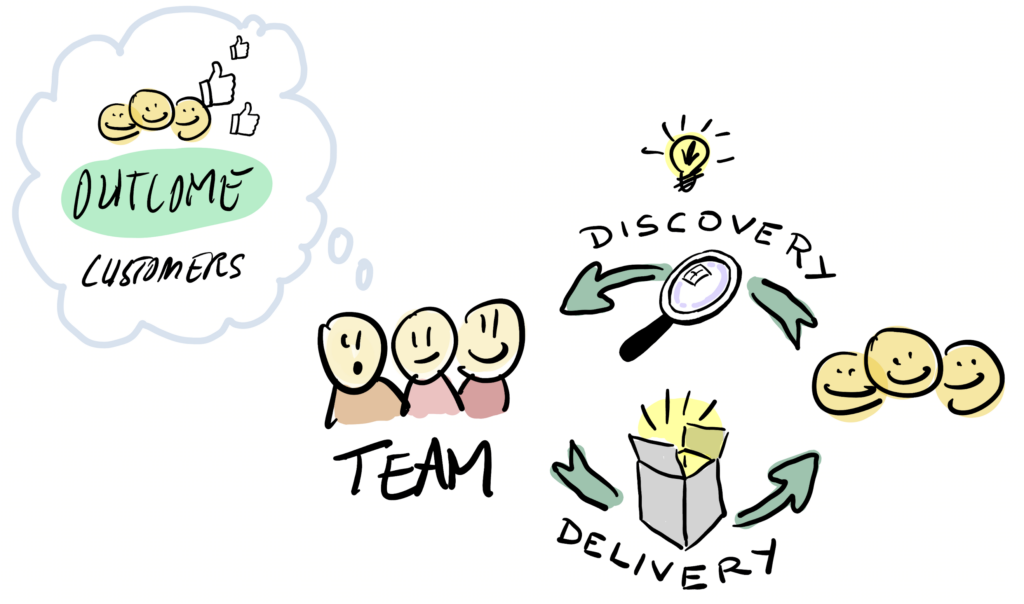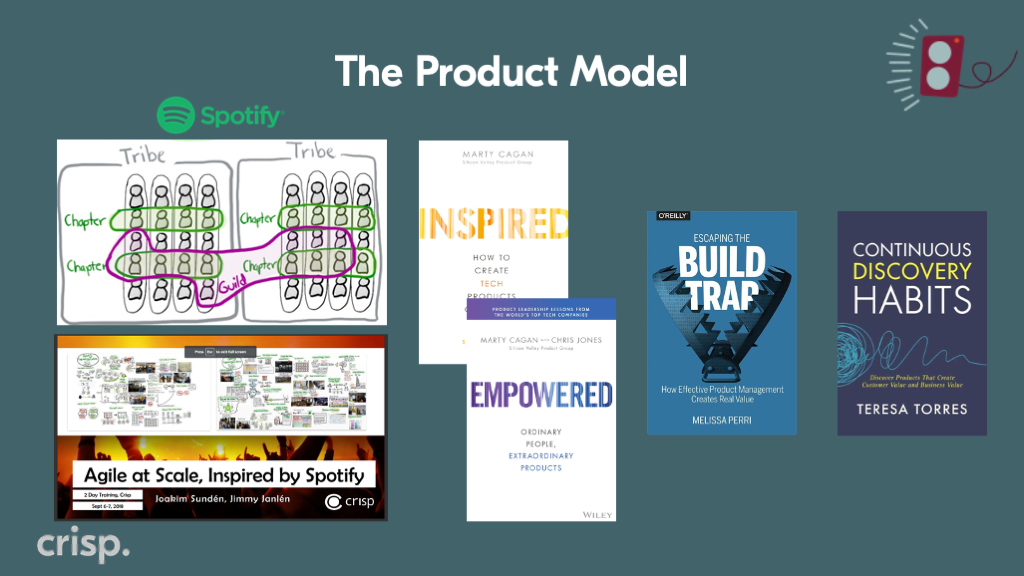The Product Model, often referred to as the ‘Product-Led model‘, ‘Product-Driven‘ model, ‘Customer-Driven‘ model, or even ‘the Spotify model’, is a topic getting a lot of attention.
This series of articles is about clarifying what it is, how it works, why it’s getting attention, and why you should care.

What is the Product Model?
To serve customers by creating products customers love, yet work for the business.
– Marty Cagan
The Product Model helps you consistently deliver innovative products that customers love, in a way that keeps them aligned with your business ambitions and needs. The Product Model is a set of values, principles, competencies, and concepts that are the result of the lessons learned from some of the world’s leading product companies. It provides a guide for engaging and empowering your teams and unleashing their innovative potential, while ensuring that their efforts are aligned with your product strategy, synchronized with your other teams, and within the boundaries defined by the business.

Does it need Decoding?
Words carry weight, and I was somewhat confused when I first heard about the Product-led model. Initially, it seems like a repackaging of the familiar agile mindset and practices but as told by Marketing and Product Managers, frustrated by the lackluster attention they got from Scrum and the Product Owner role. As my understanding evolved, I saw it as another way to describe an agile organization from the perspective of products, instead of teams. Then, it appeared as the Business Agility story retold from a tech-product organization perspective. Eventually, I realized that all the above were true and that it this was really about the Spotify model. Again. But deeper, and more meaningful than the visible and popular practices of Tribes, Squads and Guilds: about the values, principles and competencies that sustain it.
In this series of articles, I’d like to retell the story of the Product Model. Presenting it not merely as a contrast to other methods and practices but as a robust framework in its own right.
Alright, let’s decode the Product Model!
Consistent Innovation at Speed!
Why use this model? Why should you care?
The Product Model addresses the challenge of staying relevant and successful as an organization, even when the G-force of change reaches painful levels.
The model reinforces the organization’s capability to consistently innovate, at speed. It enables this mainly by empowering development teams and requiring them to have a tighter customer/user focus and interaction. The key is to adapt quickly and sustainably to the ever-changing needs of the customers and leverage the latest tech opportunities do so. As an end result, the organization has a better return on tech investments, stay easier ahead of the competition, and achieve better financial success.
Beyond Agile?
Even if they may have other names for it, many of today’s most innovative and successful companies have adopted the Product Model as their operating procedure. This includes tech giants like Google, Amazon, Apple, Facebook, and Microsoft, as well as dynamic companies such as Spotify, Klarna, Slack, Dropbox, Airtable, and Zoom, among many others. These organizations were forced to evolve and reinvent their product management processes to meet the demands of the internet’s hyper-flexibility, rapidly changing digital customer needs, and intense competition. Those companies that did that effectively – injecting Agile and Lean principles and practices, adapting them, and sustaining them in context – emerged as leaders in their fields. Interestingly, this evolution occurred concurrently across different parts of the world from the 2000s to the 2010s, with ‘the Spotify model’ being probably one of the most known examples.

Since then, numerous experts have made significant efforts to dissect, understand, and codify what sets these companies apart, leading to what we now know as the Product Model. The development of this model has been shaped by many thought leaders. In addition to our contributions at Crisp, such as the Spotify model, influential figures like Marty Cagan (author of ‘Inspired’, ‘Empowered’, and the upcoming ‘Transformed’), Melissa Perri (author of ‘The Build Trap’ and ‘Product Operations’), Teresa Torres (author of ‘Continuous Discovery’), and John Cutler have played pivotal roles. Jeff Patton also deserves a most special recognition for his contributions since the dawn of Agile.
The model has evolved to define not just the practices of these companies but also the underlying principles (like ‘fail early’), competencies (such as the roles of ‘Product Manager’ or ‘Product Designer’), and concepts (including ‘product strategy’ and ‘product discovery’). The Product Model is now attracting widespread attention, being cohesive, streamlined, and backed up with successful transformations.
Decoding the Product Model
This is all well and good, but what does it really mean? How do you do that? Especially for organizations that weren’t ‘agile’ from the start, or not born in the internet age? What’s the difference with plain-old Agile? What’s the recipe, the secret ingredient?
The articles in this series:
- The Key Insight and Core Idea powering the Product Model: What’s behind the model?
- Why your teams aren’t really empowered (and how to fix it): How to truly empower a team?
These articles are drawing from the work of many, not least from Marty Cagan and Melissa Perri, as well as insights from Crisp and my personal experiences in assisting organizations with adopting the Product Model. My goal is to present its core concepts and ideas in an accessible manner, complemented by actionable tips for implementation.
TL;DR
Too much to read, or you can’t wait for the articles to be published? Here is an overview of the whole content in this 30min video from Crisp Day 2023.
Do you have reflections, insights, ideas on the product-model that you’d like to share? Tell me!



